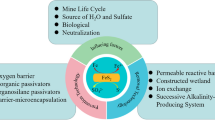Abstract
Groundwater composition may have a pronounced impact on long-term performance of permeable reactive barriers (PRBs). Here, batch and column experiments were conducted to investigate the effects of humic acid (HA) on Cr(VI) removal by pyrite in systems containing cations such as Ca2+ and Mg2+. HA was observed to have inhibitory effect on Cr(VI) uptake by pyrite under the experimental conditions studied (e.g., pH 3 to 8). HA sorbed onto pyrite surface and thus (1) competed against Cr(VI) for pyritic surface sites and/or (2) increased electrostatic repulsion between Cr(VI) and pyrite. In systems with HA and Ca2+/Mg2+, the Cr(VI) uptake by pyrite decreased drastically relative to HA alone due to the aggregation of HA with Ca2+/Mg2+. The formation of such HA aggregates/precipitates blocked Cr(VI) ions to reach its binding sites, thereby resulting in a substantial decrease in Cr(VI) uptake. Overall, the results have major implications for proper design and operation of PRBs with pyrite as the reactive material.







Similar content being viewed by others
References
APHA. (1995). Standard methods for the examinations of water and wastewater (19th ed.). Washington, DC: American Public Health Association.
Blowes, D. W., Ptacek, C. J., & Jambor, J. L. (1997). In-situ remediation of Cr(VI)-contaminated groundwater using permeable reactive walls: laboratory studies. Environmental Science & Technology, 31(12), 3348–3356.
Bonnissel-Gissinger, P., Alnot, M., Ehrhardt, J.-J., & Behra, P. (1998). Surface oxidation of pyrite as a function of pH. Environmental Science & Technology, 32, 2839–2845.
Buerge, I. J., & Hug, S. J. (1998). Influence of organic ligands on chromium (VI) reduction by iron (II). Environmental Science & Technology, 32, 2092–2099.
Bulbul, M. S., Kantar, C., & Keskin, S. (2016). Role of major groundwater ions on reductive Cr(VI) immobilization in subsurface systems with pyrite. Water, Air, & Soil Pollution, 227(3), 1–11.
Cetin, Z., Kantar, C., & Alpaslan, M. (2009). Interactions between uronic acids and Cr(III). Environmental Toxicology and Chemistry, 28, 1599–1608.
Deng, B., & Stone, A. T. (1996). Surface catalyzed chromium reduction: reactivity comparisons of different organic reductants and different oxide surfaces. Environmental Science & Technology, 30, 2484–2494.
Gaberell, M., Chin, Y.-P., Hug, S. J., & Sulzberger, B. (2003). Role of dissolved organic matter composition on the photoreduction of Cr(VI) to Cr(III) in the presence of iron. Environmental Science & Technology, 37, 4403–4409.
Kantar, C. (2007). Heterogeneous processes affecting metal ion transport in the presence of organic ligands: Reactive transport modeling. Earth-Science Reviews, 81, 175–198.
Kantar, C. (2016). Role of low molecular weight organic acids on pyrite dissolution in aqueous systems: Implications for catalytic chromium (VI) treatment. Water Science and Technology, 74(1), 99–109.
Kantar, C., & Bulbul, M. S. (2016). Effect of pH-buffering on Cr(VI) reduction with pyrite in the presence of various organic acids: Continuous-flow experiments. Chemical Engineering Journal, 287, 173–180.
Kantar, C., Cetin, Z., & Demiray, H. (2008). In situ stabilization of chromium(VI) in polluted soils using organic ligands: The role of galacturonic, glucuronic and alginic acids. Journal of Hazardous Materials, 159, 287–293.
Kantar, C. A., Keskin, S., Dagaroglu, Z. G., Karadeniz, A., & Alten, A. (2015a). Cr(VI) removal from aqueous systems using pyrite as the reducing agent: batch, spectroscopic and column experiments. Journal of Contaminant Hydrology, 174, 28–38.
Kantar, C., Ari, C., & Keskin, S. (2015b). Comparison of different chelating agents to enhance reductive Cr(VI) removal by pyrite treatment procedure. Water Research, 76, 66–75.
Lin, Y.-T., & Huang, C.-P. (2008). Reduction of chromium (VI) by pyrite in dilute aqueous solutions. Separation and Purification Technology, 63, 191–199.
Liu, T., & Lo, I. M. C. (2011). Influences of humic acid on Cr(VI) removal by zero-valent iron from groundwater with various constituents: implication for long-term PRB performance. Water, Air, and Soil Pollution, 216, 473–483.
Liu, T., Tsang, D. C. W., & Lo, I. M. C. (2008). Chromium (VI) reduction kinetics by zero-valent iron in moderately hard water with humic acid: iron dissolution and humic acid. Environmental Science & Technology, 42, 2092–2098.
Liu, T., Rao, P., Shi, J., & Lo, I. M. C. (2009). Influences of humic acid, bicarbonate and calcium on Cr(VI) reductive removal by zero-valent iron. Science of the Total Environment, 407, 3407–3414.
Liu, Y., Mou, H., Chen, L., Mirza, Z. A., & Liu, L. (2015). Cr(VI)-contaminated groundwater remediation with simulated permeable reactive barrier (PRB) filled with natural pyrite as reactive material: environmental factors and effectiveness. Journal of Hazardous Materials, 298, 83–90.
Loyaux-Lawniczak, S., Lecomte, P., & Ehrhardt, J. J. (2001). Behavior of hexavalent chromium in a polluted groundwater: redox processes and immobilization in soils. Environmental Science & Technology, 35(7), 1350–1357.
Sun, J., Mao, J., Gong, H., & Lan, Y. (2009). Fe(III) photocatalytic reduction of Cr(VI) by low-molecular weight organic acids with α-OH. Journal of Hazardous Materials, 168, 1569–1574.
Tinnacher, R. M., Nico, P. S., Davis, J. A., & Honeyman, B. D. (2013). Effects of fulvic acid on uranium (VI) sorption kinetics. Environmental Science & Technology, 47, 6214–6222.
Wall, N. A., & Choppin, G. R. (2003). Humic acids coagulation: influence of divalent cations. Applied Geochemistry, 18, 1573–1582.
Wang, Q., Cissoko, N., Zhou, M., & Xu, X. (2011). Effects and mechanisms of humic acid on chromium (VI) removal by zero-valent iron (Fe0) nanoparticles. Physics and Chemistry of the Earth, 36, 442–446.
Acknowledgements
The study was fully funded by the Scientific and Technological Research Council of Turkey (TUBITAK) under a contract number of 114Y024.
Author information
Authors and Affiliations
Corresponding author
Electronic Supplementary Material
Below is the link to the electronic supplementary material.
ESM 1
(DOC 195 kb)
Rights and permissions
About this article
Cite this article
Kantar, C., Bulbul, M.S. & Keskin, S. Role of Humic Substances on Cr(VI) Removal from Groundwater with Pyrite. Water Air Soil Pollut 228, 48 (2017). https://doi.org/10.1007/s11270-016-3233-0
Received:
Accepted:
Published:
DOI: https://doi.org/10.1007/s11270-016-3233-0




